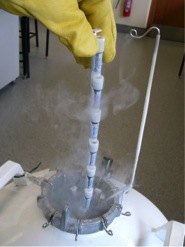
By Danielle Alyce Fanslow, Francesca Duncan, and Kate Timmerman
There are several methods of fertility preservation open to female cancer patients who wish to start a family after treatment including cryopreservation of oocytes, embryos and ovarian tissue. Cryopreservation is a method of preserving biological material by storing it at extremely low temperatures. Choosing a fertility preservation method is highly patient-specific and depends on factors such as patient age, the availability of a partner, and/or the sensitivity of the tumor to hormones. A good option for pre-pubertal patients and patients who must undergo treatment as soon as possible after diagnosis may be cryopreservation of ovarian tissue. However, current techniques for tissue cryopreservation may be improved as only 22 successful pregnancies have resulted from this method [1].
A group of Oncofertility researchers at the Oregon National Primate Research Center (Ting, Yeoman, Campos, Lawson, and Zelinksi) together with cryopreservation experts (Mullen and Fahy) have been developing new methods for cryopreserving ovarian tissue with the focus on preserving follicle health and quality. Findings from their most recent work was published in the journal Human Reproduction in an article entitled “Morphological and functional preservation of pre-antral follicles after vitrification of macaque ovarian tissue in a closed system.” This work provides insight that may lead to improved clinical protocols for ovarian tissue cryopreservation.
The goal of cryopreservation is to minimize injury to cells from the freezing process while limiting the toxicity of cryoprotective agents [2]. The current protocol for ovarian tissue cryopreservation involves slowly freezing the tissue with low concentrations of cryoprotective agents to avoid ice crystal formation inside the cell but to allow ice formation outside the cell [1]. However, ovarian tissue has an abundance of cell types and important extracellular material making it more complex to freeze compared to isolated cells. Vitrification is a method of cryopreservation that can avoid ice crystal formation inside and outside of the cell by quickly freezing the tissue with a high concentration of cryoprotective agent [3]. This method holds tremendous promise in the setting of fertility preservation and has already been applied successfully and routinely to egg and embryo freezing. However, researchers must optimize ovarian tissue vitrificaiton before it can be used in a clinical setting.
As the amount of human ovarian tissue available for research is limited, the Zelinski group used a non-human primate model to study several variables in the vitrification process including the type and concentration of cryoprotective agent used, the cooling rate, and the warming rate. As a means to assess the quality of the tissue in each experimental condition, the researchers isolated ovarian follicles from the tissue and used them for encapsulated in vitro follicle growth (eIVFG) – a technique that this group had previously applied successfully to the non-human primate. The researchers then monitored follicle health, diameter, and hormone production. Using these techniques and assays, the Zelinski group was able to determine a set of variables that resulted in the healthiest ovarian tissue. Through the findings by the Zelinski group, the field is one step closer to developing a standard protocol for ovarian tissue vitrification that can potentially result in a high rate of successful pregnancies.
References:
- Ting AY, Yeoman RR, Campos JR, Lawson MS, Mullen SF, Fahy GM, Zelinski MB. Morphological and functional preservation of pre-antral follicles after vitrification of macaque ovarian tissue in a closed system. Hum Repro. 2013. Feb 20th Ahead of Print.
- Pegg DE. The history and principles of cryopreservation. Semin Reprod Med. 2002 Feb;20(1):5-13.
- Pegg DE. The role of vitrification techniques of cryopreservation in reproductive medicine. Hum Fertil (Camb). 2005. Dec;8(4):231-9.

